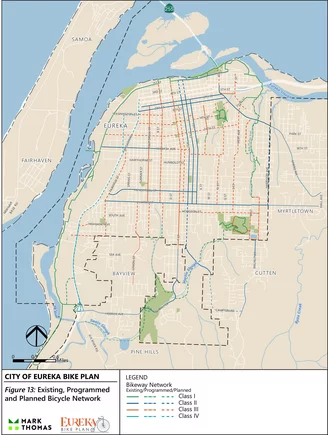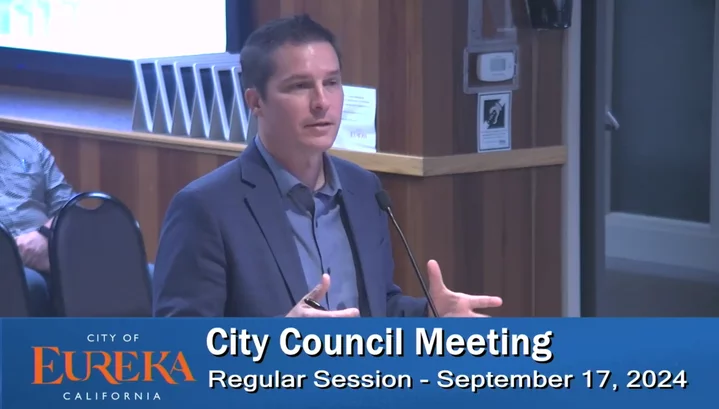The Eureka City Council last night unanimously put its seal of approval on a 518-page document meant to shepherd the city away from the present state of its streets, toward a more bike-friendly future.

Page 26 of the Bike Plan shows a map of “existing, planned and programmed” bicycle-friendly improvements to city streets. Click to enlarge.
The Eureka Bike Plan, as it’s called — get the document here — contains a whole slew of different improvements all across the city. Its goal is to make the city safely navigable for bikes.
Some of this work has been done recently, and more is on the near horizon. For instance, the city’s “C Street Bicycle Boulevard” project, which will alter C Street’s design to prevent people from using it as a north-south car corridor, has already been funded, and work is scheduled to begin next year.
But the plan — which was worked out in collaboration with the Mark Thomas consulting firm — looks even further into the future, imagining north-south and east-west bike lanes, trails and other amenities reaching almost every part of the city.
Why the need for a such a plan? Well, if the goal is to build a network, rather than just a bike path here and there for recreational purposes, it helps to have an idea of that network in mind.
But also an on-paper plan helps get things done in a million other ways. Consultant Paul Martin of the Mark Thomas firm told the council that among other things, a comprehensive document like this is of great help when the city is looking for funding opportunities.
“When we advance our transportation planning studies, the name of the game, frankly, is money, and how we can position the agency for grant success,” he said.
Paul Martin.
As became clear during public comment, the city considers the plan a “living document” subject to change, rather than a set of hard goals with hard timelines.
Rick Knapp, president of the Humboldt Bay Bicycle Commuters’ Association, told the council that while the plan was an “impressive document,” its full content — including appendices detailing potential costs — wasn’t available until five days ago.
“I just wonder whether it’s appropriate for the city to adopt this tonight when nobody really got to see it,” Knapp said. “So that’s kind of an open question to you: Is five days from the time you sent out an email to some people enough time?”
But city staff assured the council that the document is easy to amend in response to changing circumstances and evolving technology, and that seemed to be enough to sway a couple of questions councilmembers had about timing. The document was approved on a 5-0 vote.
###
At the end of last night’s meeting, City Manager Miles Slattery gave the council an update on the EaRTH Center, the big downtown development on Third Street between G and H streets that, if and when it’s ever built, will house a big apartment complex over a regional transit hub run by the Humboldt Transit Authority.
The EaRTH Center project has undergone a few changes since it was first approved by the council two and a half years ago. Cal Poly Humboldt, an early partner, has bailed out, as has the original developer. Early this summer, the city cut a new deal with local development firm Danco Builders to take over the project.
Slattery told the council that city staff is still meeting with Danco and the Humboldt Transit Authority every week or two, and that they’re finalizing plans for the space. He said that it’s looking like they’ll setting on something like 55 new low-income units for the complex, and that there should be a proposal before the city’s Design Review Committee before too long.
Mayor Kim Bergel asked Slattery, for the public’s benefit, to clarify what he meant by “low-income” housing. He assured her that these apartments, along with other downtown parking-lot con, were for “working people.”
“We have people who work for the city who have full-time jobs who could qualify for that [low-income apartment],” Slattery said. [Ed. note: The Outpost ran a really clear explainer on this a while back. Here it is, in case you missed it.]
The EaRTH Center is one of the developments targeted by Measure F, which seeks to stop the conversion of city-owned downtown parking lots into housing.

CLICK TO MANAGE